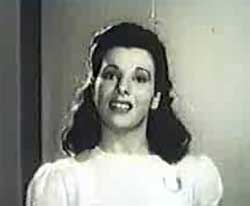 Gael Amber is the star of the jukebox soundie Swing Shift Swing (1942). It opens with images of a factory, then shows some of the workers taking a break in an entertainment lounge which has a ping pong table, piano, & a selection of wartime propaganda posters on the wall.
Gael Amber is the star of the jukebox soundie Swing Shift Swing (1942). It opens with images of a factory, then shows some of the workers taking a break in an entertainment lounge which has a ping pong table, piano, & a selection of wartime propaganda posters on the wall.
Suddenly a clarinet raises a high note, other workers have their instruments, & Gael begins belting out "When the knockin' off whistle is blowin'/ folks in overalls, where are they goin'/ You can find them where the music is blowin'/ Doin' the swing shift swing."
The unseen band is Joe Reichman & His Orchestra. The song is not outstanding & Gael was the perfect choice to sustain the mediocrity, but come the instrumental she dances a right fine boogie woogie with one of her fellow workers, then everyone's dancing, & it's in general entertaining.
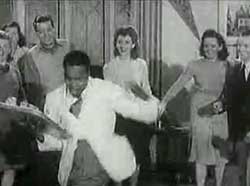 In I Don't Want to Walk Without You (1942), Kay Lorraine sings "I Don't Want to Walk Without You" supported by Merle Pitt's Five Shades of Blue. In I Don't Want to Walk Without You (1942), Kay Lorraine sings "I Don't Want to Walk Without You" supported by Merle Pitt's Five Shades of Blue.
This three-minute soundie opens in a college frat house, with some student couples dancing together, some of whom look like they're in their thirties or forties. It's the last day before graduation. Kay Lorraine sings the mediocre pop tune to her boyfriend.
There's a comedy relief dance when a clumsily dance-shufflin' negro servant (Frank Wilcox) who despite wobbly legs never dops the tray. It's an old gag, of course, with the stuff on the tray glued down. He at least has personality, unlike that room of honkies.
This is followed by several vignettes of the various couples' interactions, then a parade two by two out of the room. When the guy playing the race stereotype is the most talented performer in a short-short film, you know it's a pretty lame piece of entertainment.
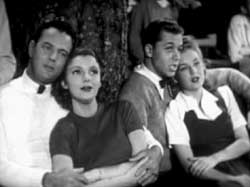 It was included in the Castle Films one-reel home-projector movie Juvenile Jubilee (1945) with two other soundies of similar stripe. On To Victory (1941) features The Collegians & the Maids of Melody, also known as the Men & Maids of Melody. It was included in the Castle Films one-reel home-projector movie Juvenile Jubilee (1945) with two other soundies of similar stripe. On To Victory (1941) features The Collegians & the Maids of Melody, also known as the Men & Maids of Melody.
It's a not-so-hot medley of college cheer songs, "Stars of the Summer Night," "The Notre Dame Victory March," & "Fight On For Old South Carolina," & incorprates a bit of newsreel footage of the Notre Dame football team & the enormous bleacher audiences.
We see the singing group at a few antics like playing ring-around-the-bonfire & holding up cards that spell "fight" trying to capture the mood of an assinine glee club. The instrumentation is provided by the unseen Ray Bloch & His Orchestra. There's a "mate" to this awaful soundie which likewise features school songs, On the Campus (1942).
Third of the Juvenile Jubilee group is I Don't Want to Set the World on Fire (1941) is sung by musical youth-commedian Johnny Downs, assisted by Bonnie Kildare, instrumentation provided by Lud Guskin & His Orchestra.
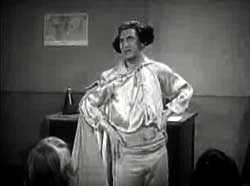 One of the looniest jukebox soundies is Our Teacher (1943), starring comedian Henny Youngman.
One of the looniest jukebox soundies is Our Teacher (1943), starring comedian Henny Youngman.
Better remembered as the "king of the one liners," there was a time when Henny had his own line of vending machines into which you placed a coin to hear him deliver a speedy slug of one-liners on whichever topic you punched on a set of buttons.
To say he can't sing is an understatement, so this really is a soundie comedy rather than anything anyone would've listened to or danced to for the song.
The set-up is Henny Youngman has been invited to a college class to speak on the topic of "the good neighbor policy." He's wearing a moronic outfit as he sings such silly lyrics as:
"They needed someone to cement south american relations/ They needed someone to be sent to all the latin nations/ So after looking around/ At last they finally found/ A proper gent/ I am the gent/ The gent that they meant/ The gent that they sent."
He jumps around & seems to be making up the moves & some of the words as he goes along. Periodic cuts to the "students" who are beautiful young women, laughing & laughing at his antics, don't disguise the problem that it's not the least bit funny. But it's so off the wall in the context of what soundies were supposed to be that it's kind of fun just for its eccentricty.
It was included as part of the trio of films Official Films packaged as a one-reel home-movie entitled Fun With Music (1945). The other two components are Margie (1942) featuring Van Alexander & His Orchestra, with Lew Hearn & Ann Mace; & G-Strings (1942) featuring comic Frank Pinero as a violinist who believes his performance is going over extraordinarily well, not knowing a beautiful showgirl (Louise Stewart) is behind him stealing the show.
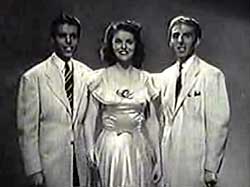 "The Dorn Brothers & Mary" in Jazzy Joe (1941) provide a retro soundie performance with ragtime orchesetra backing them up. Without that nameless orchestra, this one wouldn't be much. The singing trio harmonize like any two guys & a gal Lawrence Welk might've chosen.
"The Dorn Brothers & Mary" in Jazzy Joe (1941) provide a retro soundie performance with ragtime orchesetra backing them up. Without that nameless orchestra, this one wouldn't be much. The singing trio harmonize like any two guys & a gal Lawrence Welk might've chosen.
"Jazzy Joe & His Mohigans/ Played the music for the college hop/ All the dancers in the hall agree/ They were so corny you could hear them pop/ So they started playing in the style of 1920."
This is their cue to pull a whitebread version of the Mills Brothers imitating musical instruments. All three singers do a couple of lame "Wah wah wah" holding their hands over their mouths, & any kid could do better.
This is followed by the line "They even tried to yo oddy ay dee deedliy-doo." They imitate jews harp, followed by their best (or least awful) imitation, trumpet, all the while the back-up band clown around, intentionally being nerdy.
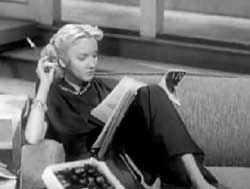 Some devottees of these charming musical film performances like to distinguish between short film musicals never intended for jukeboxes (frequently one-reelers of nine or ten minutes), two to three minute Panoram Soundies made for Mills Panoram jukeboxes, & Snader telescriptions made for television syndication. Generically they have all become "soundies" but afficionados insist on distinctions.
Some devottees of these charming musical film performances like to distinguish between short film musicals never intended for jukeboxes (frequently one-reelers of nine or ten minutes), two to three minute Panoram Soundies made for Mills Panoram jukeboxes, & Snader telescriptions made for television syndication. Generically they have all become "soundies" but afficionados insist on distinctions.
The Panoram soundies pretty much ceased production in 1946 & no new titles were released after 1947. The Snader telescriptions picked up the slack between 1950 & 1953, the majority issued in 1951.
Panoram soundies had occasionally been very theatrical productions, elsetimes just straight-out performances, though the vast majority were lip synched. The telescriptions were rarely staged elaborately, but they were generally multiply miked & are genuine live performances, whereas the soundies were pre-recorded then lip-synced for the film. So as mini-movies the Panorams have more appeal, but as live performances the Snaders win.
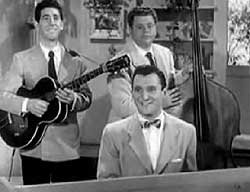 The Bobby Troup Trio performs on the title song in the Snader telescription Daddy (1951). Bobby Troup's at piano starting the vocal introduction, with doublebase & guitar standing behind him. The intro promises to tell us the story of a certain gal called Lazy Daisy Mae. The Bobby Troup Trio performs on the title song in the Snader telescription Daddy (1951). Bobby Troup's at piano starting the vocal introduction, with doublebase & guitar standing behind him. The intro promises to tell us the story of a certain gal called Lazy Daisy Mae.
Jump cut stage-left to a blonde bombsell (Virginia Maxey) lounging on her sofa, reading a fashion magazine, eating chocolates, & smoking a cigarette in a long holder.
The trio eventually becomes the background singers for Virginia singing "Hey Daddy, I want a diamond ring/ bracelets, everything/ Hey daddy, you oughta get the best for me."
It's a pretty great song in the "Diamonds are a Girl's Best Friend" & "Santa Baby" tradition, about the gleeful greed of a rich man's mistress. But others have sung it better than Virginia Maxey, including the Andrew Sisters.
The trio doing back-up are even worse than Maxey. Bobby Troup was a hipster with a fine ear for lyrics, but his arrangements were sometimes milktoast, & needed greater performers to make his numbers shine.
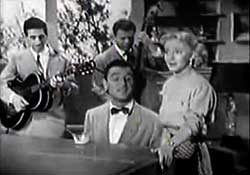 I nevertheless enjoyed Daddy for its vintage charm & kitschy pro-whoredom message. Bobby Troup wrote it in 1941, but couldn't make more than a regional hit out of it; he was able to buy a Buick with the proceeds. I nevertheless enjoyed Daddy for its vintage charm & kitschy pro-whoredom message. Bobby Troup wrote it in 1941, but couldn't make more than a regional hit out of it; he was able to buy a Buick with the proceeds.
He had the same problem with "Get Your Kicks on Route 66," a brilliant song which earned him more royalties when Nat King Cole recorded it than when he did it himself.
Another telescription, I'm Such a Hungry Man (1951), shows Bobby Troup to better advantage in his own right. It's a true hipster song about great things to eat, with support vocals again from Virginia "Ginny" Maxey.
We're shown what seems to be a living room with piano, Bobby seated thereon, doublebass & guitar completing his trio. Relaxing in & listening is Maxey, who gets up & moves to the piano on two occasions to sing her part, & is seen sitting against the back wall between assists.
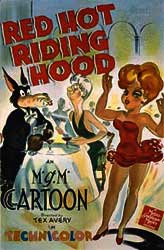 It's worth an aside here to note Bobby Troup's song "Daddy" becomes the centerpiece of Tex Avery's classic cartoon for-adult-consumption, Red Hot Riding Hood (1943).
It's worth an aside here to note Bobby Troup's song "Daddy" becomes the centerpiece of Tex Avery's classic cartoon for-adult-consumption, Red Hot Riding Hood (1943).
It opens with the standard tale of Red skipping along on her way to visit Grandma, with a wolf along the way. But before you know it, the wolf interrupts the narrator & says, "I'm fed up with that sissy stuff!" Red, Harry the wolf, & even grandma are sick of this tiresome old tale.
So the narrator backs it up to the beginning & we get the updated story. The wolf in his limousine on his way to the night club on the Sunset Strip, where Red is a headlining hoofing singer of a jitterbug babe, a curvacious red-haired Betty Grable type.
While she sings "Daddy" in her pin-up girl bathing suit, wolfie's eyes are bugging out, he pounds himself on the head with a mallet, & otherwise falls hard, & snatches her to his table after her number is done.
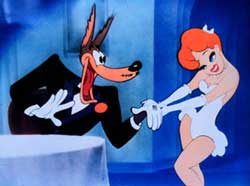 "Hey baby, what you say you & me after the show go steppin." She replies with Katherine Hepburn's voice that she has to go to Grandma's Joint after the gig. "Hey baby, what you say you & me after the show go steppin." She replies with Katherine Hepburn's voice that she has to go to Grandma's Joint after the gig.
Oh how willing he is to be her Daddy, & he lists all the cool stuff he'll give her in exchange for her favors, but he gets nowhere with her.
Soon Harry the Wolf is speeding away in order to reach Grandma's Joint before Red gets there. Grandma is so taken with him that she locks the door & aggressively attempts a seduction.
After being injured escaping through the window & plummeting to the sidewalk at Hollywood & Vine, Harry goes back to the Sunset Strip club & commits suicide during Red's act, but his desirious ghost persists.
As Tex & his crew of animators might've guessed, they had trouble getting this one past the censors, who found suicide an acceptible ending, but not the original ending with Wolf & Grandma getting married, & we even catch a glimpse of their half-human children some while later attending one of Red's performances. The censors thought this promoted bestiality.
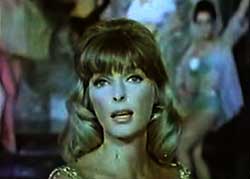 Bobby Troup married actress Julie London, who recorded a new version of Bobby's song, released not only as a minor hit single, but also as a full color scopitone film, Daddy (1966).
Bobby Troup married actress Julie London, who recorded a new version of Bobby's song, released not only as a minor hit single, but also as a full color scopitone film, Daddy (1966).
Long after the 1940s fad for Panoram jukeboxes had faded away, & even the syndicated telescriptions faded from the scene, the whole idea of video jukeboxes was re-invented as the Scopitone jukebox. Julie's Daddy was actually made for a rival video jukebox called Color Sonics, which ran 8 mm magnetic sound film, though they did also make 16 mm prints of their top sellers for scopitones.
The Color Sonics films were actually made by Official Films who had formerly been in the business of distributing soundies. High Camp was an important feature of the first wave of Scopitones, & Color Sonics increased the camp ratio if that was possible. The very first Color Sonic film was Bobby Troup's Girl Talk (1966). Julie's Daddy was the fourth Color Sonic filmed.
Julie's take on the song has her with a martini glass singing amidst soft-core strippers, beginning with a beatnik bongo beat & becoming a noisier Vegasy number as the half-clad girls prominade, evidently influenced by Red Hot Riding Hood.
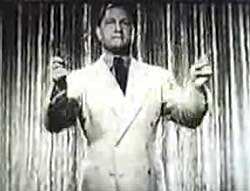 Victor Young & His Orchestra peform an arrangement of Hold That Tiger (1940), a pretty hard song to screw up since it is just naturally good camp fun. They start out pretty good with plenty of brass & a clarinet, & for a moment they're a pretty impressive band.
Victor Young & His Orchestra peform an arrangement of Hold That Tiger (1940), a pretty hard song to screw up since it is just naturally good camp fun. They start out pretty good with plenty of brass & a clarinet, & for a moment they're a pretty impressive band.
But when they start singing the minimalist lyric they begin to stink stink, then the violin section gets special highlight, totally wrecking the charm of this number. Victor Young was overly partial to the violin & just didn't know when to keep 'em subdued.
So the pleasantness of the arrangement at the start kind of falls apart as it becomes increasingly whitebread. But near the end the doublebass provides a couple good strokes. At the tail end of the soundie, three dance couples called the Six Jitterbugs rush on stage to liven up the close.
Hold that Tiger was incorporated into the three-part Castle Films one-reeler distributed as 8 mm & 16 mm films for home-viewing, under the title Syncopated Swing (1945).
This one-reeler also included The Jumpin' Jive (1941) & Are You Happy? Amen! (1942). The latter features Johnny Messner & His Orchestra. The number is set in the midst of a picnic to which dancing choras girls were invited.
Johnny & band made a half-dozen soundies, including the goofy The Biggest Aspidastra in the World (1942) playing off a vulgar pun.
Humor was common in his performances but Are You Happy? Amen! is a pretty captivating number not reliant on novelty but on good harmonies. The musicians are arranged around a set decorated to convey an outdoor setting, though it's odd to imagine going on a picnic & bringing a piano.
Girls are seated atop the upright piano, with more girls scattered among the musicians & around a picnic blanket laid out with food. Some good clarinet licks can be heard.
Everyone sways to that sweet thrum. The main singers for the integrated band are bandleader Johnny Messner & a gorgeous young woman unnamed. They take turns on the lyrics, kind of a pop-spiritual take.
The Jumpin' Jive was a 1939 Cab Calloway hit, here rendered whitebread by Ginger Harmon, instrumentation by George Steiner & His Orchestra. It can be seen performed correctly by Cab in the classic film Stormy Weather (1943)
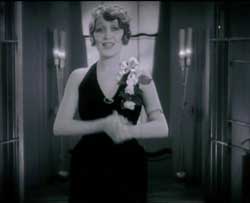 In a living room setting, Ziegfield girl & Columbia recording artist Ruth Etting sings two mediocre pop tunes in the six-minute soundie Favorite Melodies; aka, Favorite Melodies Featuring Ruth Etting; or, Ruth Etting in Favorite Melodies (1929), both numbers shot together in one continuous take. In a living room setting, Ziegfield girl & Columbia recording artist Ruth Etting sings two mediocre pop tunes in the six-minute soundie Favorite Melodies; aka, Favorite Melodies Featuring Ruth Etting; or, Ruth Etting in Favorite Melodies (1929), both numbers shot together in one continuous take.
First up is the sentimental "My Mother's Eyes" written by Abel Baer & L. Wolf Gilbert. Abel Baer wasn't one of the finer song writers, but some years earlier a younger L. Wolf Gilbert while writing with Lewis Muir had been responsible for the lyrics to such ragtime standards as "Waiting for the Robert E. Lee." Beyond the sentiment, "My Mother's Eyes" isn't that winning.
Second up is a much jazzier piece, "That's Him Now." With its ability to rhyme "If I act kookoo" with "Take a look who," it is generally quite an amusing piece, written by Milton Ager & Jack Yellen, the team who wrote Sophie Tucker's signature song "The Last of the Red Hot Mommas." One of the cooler songs Ager & Yellen wrote together was "Hard Hearted Hannah the Vamp from Savannah."
copyright © by Paghat the Ratgirl
|
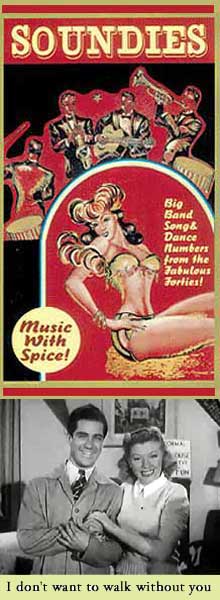


 It was included in the Castle Films one-reel home-projector movie Juvenile Jubilee (1945) with two other soundies of similar stripe. On To Victory (1941) features The Collegians & the Maids of Melody, also known as the Men & Maids of Melody.
It was included in the Castle Films one-reel home-projector movie Juvenile Jubilee (1945) with two other soundies of similar stripe. On To Victory (1941) features The Collegians & the Maids of Melody, also known as the Men & Maids of Melody.


 The Bobby Troup Trio performs on the title song in the Snader telescription Daddy (1951). Bobby Troup's at piano starting the vocal introduction, with doublebase & guitar standing behind him. The intro promises to tell us the story of a certain gal called Lazy Daisy Mae.
The Bobby Troup Trio performs on the title song in the Snader telescription Daddy (1951). Bobby Troup's at piano starting the vocal introduction, with doublebase & guitar standing behind him. The intro promises to tell us the story of a certain gal called Lazy Daisy Mae. I nevertheless enjoyed Daddy for its vintage charm & kitschy pro-whoredom message. Bobby Troup wrote it in 1941, but couldn't make more than a regional hit out of it; he was able to buy a Buick with the proceeds.
I nevertheless enjoyed Daddy for its vintage charm & kitschy pro-whoredom message. Bobby Troup wrote it in 1941, but couldn't make more than a regional hit out of it; he was able to buy a Buick with the proceeds.
 "Hey baby, what you say you & me after the show go steppin." She replies with Katherine Hepburn's voice that she has to go to Grandma's Joint after the gig.
"Hey baby, what you say you & me after the show go steppin." She replies with Katherine Hepburn's voice that she has to go to Grandma's Joint after the gig.

